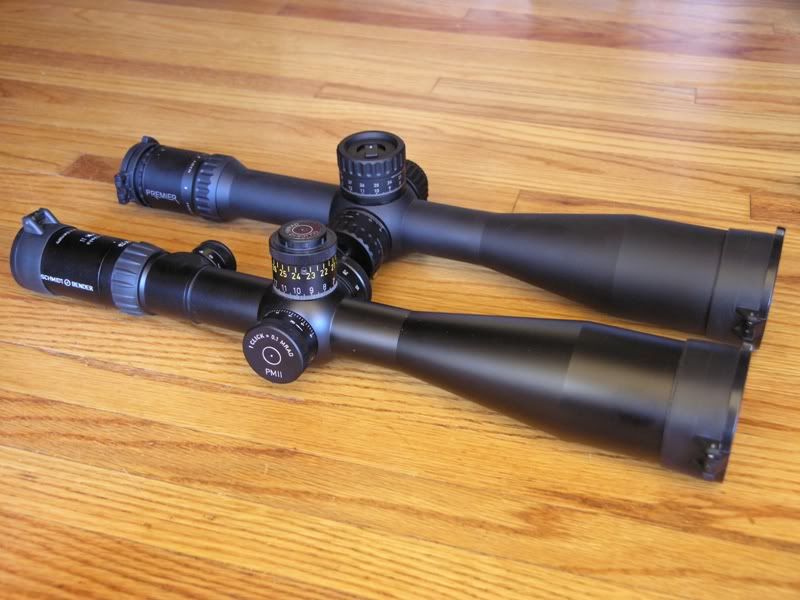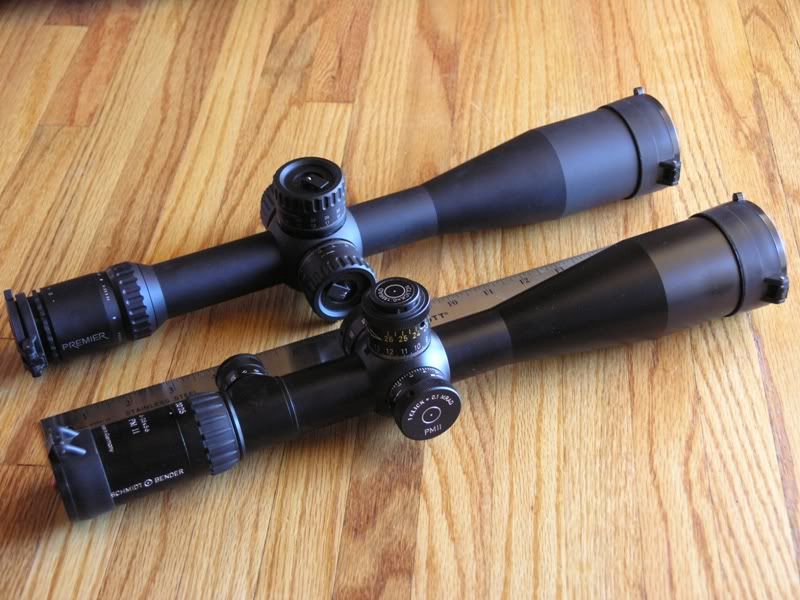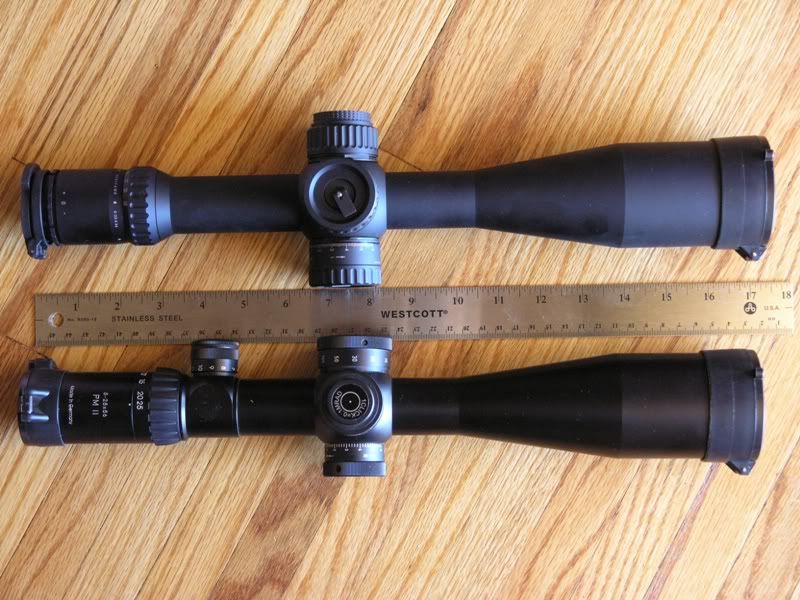Re: Premier or S&B
<div class="ubbcode-block"><div class="ubbcode-header">Originally Posted By: Goldie</div><div class="ubbcode-body">i know Ive seen this question here before but cant find the post now that Im ready to buy. i do remember LL's comment the the Premier is better scope, but believe that was regarding the lower power. Hs anyone tried the new 5X25 Premier and how does it compare to the S&B, primarily in quality of glass...at 60 the old eyes need every advantage they can get. thanx, nd feel free to pm me. </div></div>
First off, I have never been in the military or LE, nor am I an optical engineer or otherwise an expert in glass or coatings. I do know superior machining from excellent machining and know hype from fact. I don't beat on my stuff but my most of my guns aren't safe queens either.
That said, and being the owner of a PMII 5-25X Gen 2 XR CCW and a Heritage 5-25X Gen 2 XR MTC I do have a bit layman's insight directly related to the "S & B PMII 5-25X Gen 2 XR vs. Premier Heritage 5-25X Gen 2 XR" question. Obviously this is not representative of the respective scope lines, but rather my layman's comments about my particular samples.
<span style="font-weight: bold"><span style="font-style: italic">Features/characteristics common between my S & B PMII 5-25X DT CM LP Gen 2 XR CCW and Premier Heritage 5-25X Gen 2 XR MTC:</span></span>
<span style="font-weight: bold">Build Quality -</span>
Both are built for rugged use and dependability. As I said I don't purposefully beat on my stuff, so although I can and do "box test" my scopes for accuracy and repeatability of adjustments more than likely I'll never have to warranty either one. S & B scopes have a proven track record for durability, although anything can break. Premier scopes haven't been out long enough to have a track record, but I have no doubt that they will be proven very durable by those in the field in harm's way. Those are the tests that really matter.
<span style="font-weight: bold">PMII 5-25X Gen 2 XR and Heritage 5-25X Gen 2 XR Reticles -</span>
Although the measurements and subtensions are identical between the two scopes <span style="font-style: italic">on paper</span>, when you look through the two scopes the reticles appear quite different. Not only do the subtensions of the Heritage appear heavier and stand-out more, but the reticle also looks distinctly "more "black" (and thus easier to see) compared to the PMII. If the only difference between the reticles was the darker, blacker appearance of the Heritage Gen 2 XR might chock it up to better glass coatings and/or more efficient baffles inside the tube, but its more than that - as if the reticle is etched differently. I have to wonder how accurate the marked magnifications on the ocular housings are (the numbered magnifications may or may not be accurate, so this could also play a part in the apparent visual differences. Although, I would definitely notice the difference in reticle and image size between the two if a magnification discrepancy was indeed the cause of the visual differences.
I had old Premier PDFs' of the 4-16X and 5-25X PMII Gen 2 XR (at 15X) and I compared the subtensions and measurements to PDFs' of the Heritage 3-15X and 5-25X (at 15X) that I had pulled off the web before. The subtensions and measurements were identical between the two Heritage Gen 2 XR scopes, with the line widths being thicker than on the PMIIs'. At 17X, my GAP reticle was slightly more coarse at 17X than the PMII at 17X but slightly less coarse than the Heritage at 17X (again, the PMII and Heritage 5-25Xs' are supposed to be the same). The GAP schematic is spec'ed at .1 MOA/2.65938mms' at 100 yards, compared to 0.025 MIL/0.09"/2.28600mm for both the Heritage and PMII 5-25X Gen 2 XRs'.
I PM'ed Jerry (Ricker) at Premier, and asked him about the subtensions and measurements of the Heritage 5-25X compared to the PMII 5-25X, explaining that the Heritage vertical and horizontal line widths "look thicker". Jerry emailed me, sending me an updated PDF of the Heritage 5-25X Gen 2 XR. The Heritage 5-25X Gen 2 XR PDF Jerry sent me has identical specs to the PMII 4-16X and 5-25X Gen 2 XR.
Once I mount the Heritage and have time I'll try to get some decent photos of the reticles at various powers and post them on the Hide'. Of course, people will have to realize and take into account that the marked magnifications on the ocular housings may or may not be actual magnifications, and that scopes will vary slightly.
<span style="font-weight: bold"><span style="font-style: italic">Features/characteristics specific between my S & B PMII 5-25X DT CM LP Gen 2 XR CCW and Premier Heritage 5-25X Gen 2 XR MTC:</span></span>
<span style="font-weight: bold"><span style="text-decoration: underline">S & B PMII 5-25X Gen 2 XR DT CM LP CCW</span></span>
<span style="font-weight: bold"><span style="font-style: italic">Clarity -</span></span>
<span style="font-style: italic">To my eyes</span>, as excellent as my PMII 5-25X is, the Heritage 5-25X appears to have a very slight edge in both resolution and color rendition. Not a huge difference, but <span style="font-style: italic">very slightly</span> better than my PMII in both). Edge-to-edge they seem equal.
<span style="font-weight: bold"><span style="font-style: italic">Field of View -</span> </span>
I have seen people mention that the PMII's FOV is restricted at low power (when you dial down to 5X, a black ring is visible around the image) and this ring doesn't go away until magnification is increased to about 6-6.5X). My personal scope exhibits this, and the ring completely disappears by 6.5X. I don't worry about this, as I rarely dial below 10X anyway.
<span style="font-weight: bold">ADJUSTMENTS - </span>
<span style="font-style: italic"><span style="font-weight: bold">Turrets</span></span>
The PMII has much more solid and definite "clicks" than my Heritage 5-25X. The PMII's clicks are very solid and definite, without the slightest hint of mushiness. However, since the PMII lacks a MTC ("More Tacile Click") option (each full MIL has a heavier detent) all the clicks feel the same and you have to look at the dial or count clicks. In this sense, adjustments must be done carefully and deliberately in order to avoid under or over-shooting your desired setting. An MTC would allow you to crank the full MILs fast, then slow down when you get close. I wish that the PMII was available with an MTC. The Elevation and Windage knobs turn easily and smoothly, with what I consider adequate resistence - not too stiff but not too easy to turn. Some might consider them too easy-to-turn in the field.
<span style="font-style: italic"><span style="font-weight: bold">Parallax Knob</span></span>
The Parallax knob turns easily and smoothly, with a what is IMHO just the right amount of resistance. CCW rotation (you turn the knob "away from you" to focus on distant objects, and turn the knob toward you to focus on closer objects).
<span style="font-style: italic"><span style="font-weight: bold">Illumination</span></span>
The Illumination rheostat is located in a separate housing on the LH side of the tube, just forward of the Ocular Bell, and has 11 settings plus "O"/Off. The settings are marked 0-11. Turning the illumination Knob CCW <span style="font-style: italic">(away from you)</span> increases the intensity of the illumnation (unlike on the Heritage, where the illumination increases in a CW direction).
There are two things I dislike about the PMII's Illumination adjustment: (1), the rheostat's location on the tube reduces the amount of space available for the rear ring, and (2) the rheostat must be turned from "0"/"Off" to the desired setting (there is no "off" position between each intensity setting). Turning the illumination dial to between any one of the numbered settings will actually turn-off the illumination, thus conserving battery power, but his is risky as the knob turns easily between the setting detents and could accidently be turned back on). At best, you could drain your CR2032 battery. At worst, operators could give away their position to the bad guys.
<span style="font-style: italic"><span style="font-weight: bold">Diopter Setting</span></span>
The Diopter Setting is rubber-covered, so it provides some protection from high-recoiling calibers if you don't leave a lens cover on the ocular while shooting. The adjustment is stiff-to-turn, which is as it shoud be. The stiff setting means you won't alter the setting with a bump or by flipping open the cover.
<span style="font-weight: bold"><span style="text-decoration: underline">Premier Heritage 5-25X Gen 2 XR:</span></span>
<span style="font-weight: bold"><span style="font-style: italic">Clarity -</span></span>
As I mentioned above, <span style="font-style: italic">to my eyes</span>, as excellent as my PMII 5-25X is, my Heritage 5-25X appears to have a very slight edge in both resolution and color rendition. Not a huge difference, but <span style="font-style: italic">very slightly</span> better than my PMII in both). Edge-to-edge they seem equal.
<span style="font-weight: bold"><span style="font-style: italic">Field of View -</span> </span>
For the most part, my Heritage 5-25X does not exhibit this "problem". I say, <span style="font-style: italic">"for the most part"</span> because the way the ocular housing is timed the "5" doesn't line-up exactly. The magnification needs to be turned very slightly higher than the 5X stop, or else a ring will also be seen. Again, I don't worry about this, as I rarely dial below 10X anyway.
<span style="font-weight: bold">ADJUSTMENTS - </span>
<span style="font-style: italic"><span style="font-weight: bold">Turrets</span></span>
The Heritage clicks are "softer" and <span style="font-style: italic">on my scope</span> they feel a sort of mushy and indefinite. Because of this, adjustments must be done carefully and deliberately in order to dial your desired setting because sometimes you can't feel the "click". While the clicks aren't terrible, if they don't improve I will contact Premier about sending the scope in for them to look at and "tweek" - from reading a thread here on the Hide', a Heritage 3-15X owner had this complaint and sent his scope in. I don't recall whether this was a 22 MIL ST (I believe it was, because IIRC it was an early 3-15X) or a 15 MIL ST. At any rate, Premier "fixed" the scope and the customer is happy now.
The Heritage is available with a "MTC" (More Tacile Click) option (each full MIL has a heavier detent), allowing you to dial in complete darkness. You can crank the full MILs fast, then slow down when you get close. The MTC feature of the Heritage is really cool for adjusting full MILs' without looking, although as I mentioned above, anything other than a full MIL requires attentive, deliberate dialing in order to not under or overshoot the adjustment you want (this is because of the "mushiness" of my clicks). The "MTC" is a very cool option that I wish was available on the PMII.
<span style="font-weight: bold"><span style="font-style: italic">Toolless Re-zeroing</span></span>
Very cool feature to have - just flip the toggle up and over, set the knob where desired, and flip the toggle back down and you're set (unlike the PMII turrets which require a small screwdriver to loosen/tighten two screws that secure the turrets to the erector assembly). No tools needed and no screws to lose!
<span style="font-style: italic"><span style="font-weight: bold">Parallax Knob</span></span>
The Parallax knob turns easily and smoothly, and is slightly stiffer than on my PMII. Its' GTG. As on my CCW PMII 5-25X, CCW rotation (turning the knob "away from you" focuses on distant objects, and turning the knob toward you to focuses on closer objects).
<span style="font-style: italic"><span style="font-weight: bold">Illumination</span></span>
The Illumination rheostat is ingeniously incorporated into the Parallax Knob Housing, and has 11 settings, plus "0"/Off. The settings are marked 0-11. Turning the illumination Knob CW (towards you increases the intensity of the numbers (unlike on the PMII, where the illumination intensity increases in a CCW direction). I do wish that the illumination rheostat adjusted in a CCW fashion like the other controls.
By incorporating the illumination rheostat into the Parallax housing, Premier has solved one of the things that I dislike about the PMII's illumination rheostat - (losing ring space on the tube). The Heritage's illumination rheostat pulls out of the Parallax housing for use, and stores out of harm's way when not in use. Very Cool. Plus, the rheostat has just the right amount of tension to keep it in whatever position you place it in. This allows you to turn the illumination off between settings without fear of the illumination being bumped back-on.
<span style="font-style: italic"><span style="font-weight: bold">Diopter Setting</span></span>
As on my PMII, the Diopter Setting is stiff-to-turn, which is as it shoud be. It is not rubber-coated, so beware of high-recoiling rifles. The stiff setting means you won't alter the setting with a bump or by flipping open the cover. Something worth noting, is that the diopter adjustment ring is machined to accept Premier's Articulating Lens Cover, and the angle at which the ring is machined doesn't give you a lot to grab onto when adjusting the diopter. This is fine with me, as it helps prevent my friends from messing with my diopter adjustment.
<div class="ubbcode-block"><div class="ubbcode-header">Originally Posted By: DC Smith</div><div class="ubbcode-body">Even more important (again, to me) is the fact that the Premiers come with CCW knobs. At one point CCW knobs were available from S&B, but after a year of looking I never found a S&B 5-25 with CCW actually available for sale...</div></div>
<span style="font-weight: bold">DC</span>, you may have been looking before these became available, but <span style="font-weight: bold">CANAVAR</span> recently sold two
<span style="font-weight: bold"><span style="font-style: italic">NIB S&B 5-25 PMII LP GEN II XR CCW .1mrad</span></span> scopes for less than what I have in mine. Also, if you really want one, you can always send a a S & B back to Germany to have the adjustments converted to CCW. Thats' what I did. It took for months but it was worth it for me.
However, I have been informed by Mark Cromwell ( at S & B USA) that S & B USA has brought technical equipment over here and is working on training technical staff here so that scopes can be serviced Stateside.
Keith





